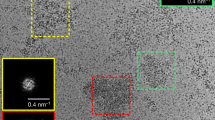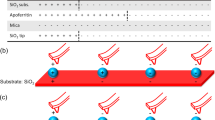Abstract
The assembly reaction of Escherichia coli ferritin A (EcFtnA) was studied using time-resolved small-angle X-ray scattering (SAXS). EcFtnA forms a cage-like structure that consists of 24 identical subunits and dissociates into dimers at acidic pH. The dimer maintains native-like secondary and tertiary structures and can reassemble into a 24-mer when the pH is increased. The time-dependent changes in the SAXS profiles of ferritin during its assembly were roughly explained by a simple model in which only tetramers, hexamers, and dodecamers were considered intermediates. The rate of assembly increased with increasing ionic strength and decreased with increasing pH (from pH 6 to pH 8). These tendencies might originate from repulsion between assembly units (dimers) with the same net charge sign. To test this hypothesis, ferritin mutants with different net charges (net-charge mutants) were prepared. In buffers with low ionic strength, the rate of assembly increased with decreasing net charge. Thus, repulsion between the assembly unit net charges was an important factor influencing the assembly rate. Although the differences in the assembly rate among net-charge mutants were not significant in buffers with an ionic strength higher than 0.1, the assembly rates increased with increasing ionic strength, suggesting that local electrostatic interactions are also responsible for the ionic-strength dependence of the assembly rate and are, on average, repulsive.




Similar content being viewed by others
References
Alberts B, Johnson A, Lewis J, Raff M, Roberts K, Walter P (2002) Molecular biology of the cell, 4th edn. Garland Science, New York
Balejcikova L, Garamus VM, Avdeev MV, Petrenko VI, Almasy L, Kopcansky P (2017) The effect of solution pH on the structural stability of magnetoferritin. Colloids Surf B: Biointerfaces 156:375–381. https://doi.org/10.1016/j.colsurfb.2017.05.036
Bielig HJ, Kratky O, Rohns G, Wawra H (1966) Small-angle scattering of apoferritin in solution. BBA - Biophys Incl Photosynth 112:110–118. https://doi.org/10.1016/S0926-6585(96)90013-8
Carmona F, Poli M, Bertuzzi M, Gianoncelli A, Gangemi F, Arosio P (2017) Study of ferritin self-assembly and heteropolymer formation by the use of fluorescence resonance energy transfer (FRET) technology. Biochim Biophys Acta 1861:522–532. https://doi.org/10.1016/j.bbagen.2016.12.011
Ciasca G et al (2012) Transient state kinetic investigation of ferritin iron release. Appl Phys Lett 100. https://doi.org/10.1063/1.3685706
Crichton RR, Bryce CF (1973) Subunit interactions in horse spleen apoferritin. Dissociation by extremes of pH. Biochem J 133:289–299. https://doi.org/10.1042/bj1330289
Fischbach FA, Anderegg JW (1965) An X-ray scattering study of ferritin and apoferritin. J Mol Biol 14:458–IN415. https://doi.org/10.1016/S0022-2836(65)80196-6
Gálvez N et al (2008) Comparative structural and chemical studies of ferritin cores with gradual removal of their Iron contents. J Am Chem Soc 130:8062–8068. https://doi.org/10.1021/ja800492z
Gerl M, Jaenicke R (1987) Mechanism of the self-assembly of apoferritin from horse spleen. Cross-linking and spectroscopic analysis. Eur Biophys J 15:103–109
Gerl M, Jaenicke R, Smith JM, Harrison PM (1988) Self-assembly of apoferritin from horse spleen after reversible chemical modification with 2,3-dimethylmaleic anhydride. Biochemistry 27:4089–4096
Glatter O, Kratky O (1982) Small angle x-ray scattering / edited by O. Glatter and O. Kratky. vol Accessed from http://nla.gov.au/nla.cat-vn265921. Academic Press, London; New York
Griffiths DF, Higham DJ (2010) Numerical methods for ordinary differential equations: initial value problems. Springer, London
Johnson E, Cascio D, Sawaya MR, Gingery M, Schröder I (2005) Crystal structures of a tetrahedral open pore ferritin from the hyperthermophilic archaeon Archaeoglobus fulgidus. Structure 13:637–648. https://doi.org/10.1016/j.str.2005.01.019
Kim M, Rho Y, Jin KS, Ahn B, Jung S, Kim H, Ree M (2011) pH-dependent structures of ferritin and apoferritin in solution: disassembly and reassembly. Biomacromolecules 12:1629–1640. https://doi.org/10.1021/bm200026v
Kler S et al (2012) RNA encapsidation by SV40-derived nanoparticles follows a rapid two-state mechanism. J Am Chem Soc 134:8823–8830. https://doi.org/10.1021/ja2110703
Kraft P et al (2009) Performance of single-photon-counting PILATUS detector modules. J Synchrotron Radiat 16:368–375. https://doi.org/10.1107/S0909049509009911
Kutter S, Eichner T, Deaconescu AM, Kern D (2016) Regulation of microtubule assembly by tau and not by Pin1. J Mol Biol 428:1742–1759. https://doi.org/10.1016/j.jmb.2016.03.010
Kuwata T, Okada Y, Yamamoto T, Sato D, Fujiwara K, Fukumura T, Ikeguchi M (2019) Structure, function, folding, and aggregation of a neuroferritinopathy-related ferritin variant. Biochemistry. https://doi.org/10.1021/acs.biochem.8b01068
Melnikova L et al (2014) Effect of iron oxide loading on magnetoferritin structure in solution as revealed by SAXS and SANS. Colloids Surf B: Biointerfaces 123:82–88. https://doi.org/10.1016/j.colsurfb.2014.08.032
Oda T, Aihara T, Wakabayashi K (2016) Early nucleation events in the polymerization of actin, probed by time-resolved small-angle x-ray scattering. Sci Rep 6:34539. https://doi.org/10.1038/srep34539
Ohtomo H et al (2015) A physicochemical and mutational analysis of intersubunit interactions of Escherichia coli ferritin A. Biochemistry 54:6243–6251. https://doi.org/10.1021/acs.biochem.5b00723
Sana B, Johnson E, Magueres PL, Criswell A, Cascio D, Lim S (2013) The role of nonconserved residues of archaeoglobus fulgidus ferritin on its unique structure and biophysical properties. J Biol Chem 288:32663–32672. https://doi.org/10.1074/jbc.M113.491191
Santambrogio P, Levi S, Cozzi A, Rovida E, Albertini A, Arosio P (1993) Production and characterization of recombinant heteropolymers of human ferritin H and L chains. J Biol Chem 268:12744–12748
Sato D, Ohtomo H, Yamada Y, Hikima T, Kurobe A, Fujiwara K, Ikeguchi M (2016a) Ferritin assembly revisited: a time-resolved small-angle X-ray scattering study. Biochemistry 55:287–293. https://doi.org/10.1021/acs.biochem.5b01152
Sato D, Takebe S, Kurobe A, Ohtomo H, Fujiwara K, Ikeguchi M (2016b) Electrostatic repulsion during ferritin assembly and its screening by ions. Biochemistry 55:482–488. https://doi.org/10.1021/acs.biochem.5b01197
Shemesh A, Ginsburg A, Levi-Kalisman Y, Ringel I, Raviv U (2018) Structure, assembly, and disassembly of tubulin single rings. Biochemistry 57:6153–6165. https://doi.org/10.1021/acs.biochem.8b00560
Stefanini S, Chiancone E, Arosio P, Finazzi-Agro A, Antonini E (1982) Structural heterogeneity and subunit composition of horse ferritins. Biochemistry 21:2293–2299
Stefanini S, Vecchini P, Chiancone E (1987) On the mechanism of horse spleen apoferritin assembly: a sedimentation velocity and circular dichroism study. Biochemistry 26:1831–1837
Stillman TJ et al (2001) The high-resolution X-ray crystallographic structure of the ferritin (EcFtnA) of Escherichia coli; comparison with human H ferritin (HuHF) and the structures of the Fe(3+) and Zn(2+) derivatives. J Mol Biol 307:587–603. https://doi.org/10.1006/jmbi.2001.4475
Svergun D, Barberato C, Koch MHJ (1995) CRYSOL - a program to evaluate x-ray solution scattering of biological macromolecules from atomic coordinates. J Appl Crystallogr 28:768–773. https://doi.org/10.1107/S0021889895007047
Tresset G et al (2013) Norovirus capsid proteins self-assemble through biphasic kinetics via long-lived stave-like intermediates. J Am Chem Soc 135:15373–15381. https://doi.org/10.1021/ja403550f
Tuma R, Tsuruta H, French KH, Prevelige PE (2008) Detection of intermediates and kinetic control during assembly of bacteriophage P22 procapsid. J Mol Biol 381:1395–1406. https://doi.org/10.1016/j.jmb.2008.06.020
Acknowledgments
This work was supported in part by a Sasakawa Scientific Research Grant (to D.S.) from the Japan Science Society. The synchrotron radiation SAXS experiments were performed at BL45XU of SPring-8 with the approval of the Japan Synchrotron Radiation Research Institute (JASRI), Hyogo, Japan (proposals 2011A1133, 2012A1217, 2012B1114, 2013B1392, 2015A1374, 2016B1217, 2017A1403, 2017B1308, 2018A1062, 2018A1262, and 2018B1404). This research was supported in part by the Platform for Drug Discovery, Information, and Structural Life Science of the Ministry of Education, Culture, Sports, Science and Technology of Japan. The authors thank Dr. Takaaki Hikima of RIKEN for assistance with the beamline alignment.
Author information
Authors and Affiliations
Corresponding author
Ethics declarations
Conflict of interest
Daisuke Sato declares that he has no conflict of interest. Masamichi Ikeguchi declares that he has no conflict of interest.
Ethical approval
This article does not contain any studies with human participants or animals performed by any of the authors.
Additional information
Publisher’s note
Springer Nature remains neutral with regard to jurisdictional claims in published maps and institutional affiliations.
This article is part of a Special Issue dedicated to the ‘2018 Joint Conference of the Asian Biophysics Association and Australian Society for Biophysics’ edited by Kuniaki Nagayama, Raymond Norton, Kyeong Kyu Kim, Hiroyuki Noji, Till Böcking, and Andrew Battle.
Rights and permissions
About this article
Cite this article
Sato, D., Ikeguchi, M. Mechanisms of ferritin assembly studied by time-resolved small-angle X-ray scattering. Biophys Rev 11, 449–455 (2019). https://doi.org/10.1007/s12551-019-00538-x
Received:
Accepted:
Published:
Issue Date:
DOI: https://doi.org/10.1007/s12551-019-00538-x




